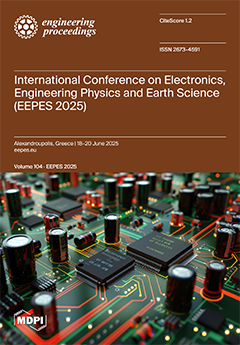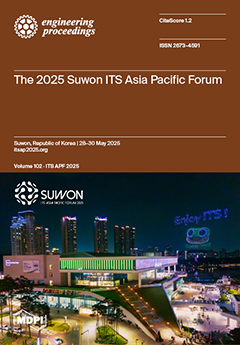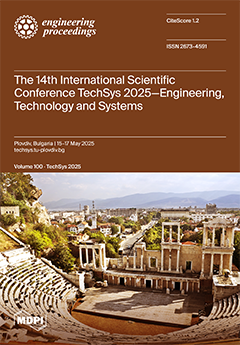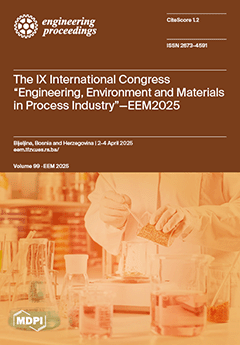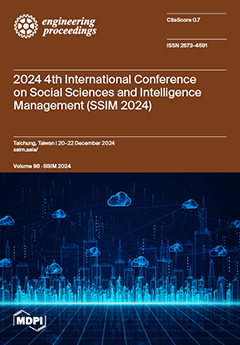Journal Description
Engineering Proceedings
Engineering Proceedings
is an open access journal dedicated to publishing findings resulting from conferences, workshops, and similar events, in all areas of engineering. The conference organizers and proceedings editors are responsible for managing the peer-review process and selecting papers for conference proceedings.
Latest Articles
Soft Gripper Gloves with Mirroring System Design for Hand Rehabilitation
Eng. Proc. 2025, 103(1), 29; https://doi.org/10.3390/engproc2025103029 - 18 Sep 2025
Abstract
►
Show Figures
Over the last decade, soft robotic gripper systems, such as grippers, have been used in a variety of applications, particularly in human rehabilitation. This study aims to enhance the rehabilitation process by creating a mirroring system glove for hand paralysis patients due to
[...] Read more.
Over the last decade, soft robotic gripper systems, such as grippers, have been used in a variety of applications, particularly in human rehabilitation. This study aims to enhance the rehabilitation process by creating a mirroring system glove for hand paralysis patients due to injury, stroke, hemiplegia, and others. A soft and flexible liquid silicone rubber (LSR) was used to develop and build a pair of gloves to improve comfort and safety compared with rigid rehabilitation equipment. The non-affected hand’s sensory glove, equipped with flex sensors, detects motion by measuring the bending angle at each finger. The other glove uses Arduino and a pneumatic system to help the afflicted hand accomplish training exercises. The new design of a gripper is important for manufacturing gloves that provide acceptable gripping behavior.
Full article
Open AccessProceeding Paper
Smartphone-Based Biosensors: Current Trends, Challenges, and Future Prospects
by
Adinife Patrick Azodo, Tochukwu Canice Mezue and Idama Omokaro
Eng. Proc. 2025, 106(1), 10; https://doi.org/10.3390/engproc2025106010 - 18 Sep 2025
Abstract
►▼
Show Figures
Smartphone-based biosensors are emerging as transformative tools for personalized medicine and real-time health monitoring. This study critically examines recent advancements in mass-sensitive, optical, and electrochemical biosensing technologies, highlighting their application in detecting disease biomarkers. Beyond a summary of technological progress, this paper presents
[...] Read more.
Smartphone-based biosensors are emerging as transformative tools for personalized medicine and real-time health monitoring. This study critically examines recent advancements in mass-sensitive, optical, and electrochemical biosensing technologies, highlighting their application in detecting disease biomarkers. Beyond a summary of technological progress, this paper presents a strategic roadmap that addresses persistent barriers to clinical deployment, including sensor calibration inconsistencies, lack of interoperability, and limited scalability. The proposed framework leverages explainable artificial intelligence (AI) for enhanced diagnostic interpretation and outlines pathways for low-cost, scalable manufacturing using advanced nanomaterials. By bridging technical innovation with practical implementation, this work contributes a replicable model for developing equitable, reliable smartphone biosensors capable of expanding access to preventive and individualized healthcare worldwide.
Full article

Figure 1
Open AccessEditorial
Statement of Peer Review
by
Teodor Iliev, Ivaylo Stoyanov, Grigor Mihaylov, Panagiotis Kogias and Jacob Fantidis
Eng. Proc. 2025, 104(1), 97; https://doi.org/10.3390/engproc2025104097 - 17 Sep 2025
Abstract
In submitting conference proceedings to Engineering Proceedings, the volume editors of the proceedings certify to the publisher that all papers published in this volume have been subjected to peer review administered by the volume editors [...]
Full article
(This article belongs to the Proceedings of International Conference on Electronics, Engineering Physics and Earth Science (EEPES 2025))
Open AccessProceeding Paper
Strength Analysis of Wood Frame Structures Based on SNI 7973:2013 and Load Modeling on SAP 2000 Application Technology: The Kasepuhan Sinar Resmi Traditional House
by
Sofa Lailatul Ma’rifah, Paikun, Nadhya Susilo Nugroho, Siti Maemunah and Muhammad Deva Prayoga
Eng. Proc. 2025, 107(1), 90; https://doi.org/10.3390/engproc2025107090 - 17 Sep 2025
Abstract
The uniqueness of traditional houses in Kasepuhan Sinar Resmi lies in the use of natural materials. However, over time, this uniqueness has become increasingly rare. The contributing factors include a lack of public awareness about the importance of preserving traditional house culture, the
[...] Read more.
The uniqueness of traditional houses in Kasepuhan Sinar Resmi lies in the use of natural materials. However, over time, this uniqueness has become increasingly rare. The contributing factors include a lack of public awareness about the importance of preserving traditional house culture, the absence of standardized designs, uncertainty regarding the quantity of required building materials, and difficulties in sourcing materials. If left unaddressed, these issues could lead to the loss of the uniqueness of traditional houses. This study employs observation methods to produce designs that align with ancestral traditions, interviews to gather detailed information, and structural analysis based on SNI 7973:2013 standards using the SAP2000 application. These approaches aim to determine effective and safe wooden material dimensions in accordance with Indonesian standards. The primary goal of this research is to produce a traditional house design that meets both cultural and national standards, serving as a guideline for the Kasepuhan Sinar Resmi community in building traditional houses. Additionally, the findings are expected to serve as a reference for policymakers in providing resources for building materials, supporting the preservation of these unique traditional houses.
Full article
(This article belongs to the Proceedings of The 7th International Global Conference Series on ICT Integration in Technical Education & Smart Society)
►▼
Show Figures

Figure 1
Open AccessEditorial
Preface: The International Conference on Electronics, Engineering Physics and Earth Science (EEPES 2025)
by
Teodor Iliev, Ivaylo Stoyanov, Grigor Mihaylov, Panagiotis Kogias and Jacob Fantidis
Eng. Proc. 2025, 104(1), 96; https://doi.org/10.3390/engproc2025104096 - 16 Sep 2025
Abstract
The fourth edition of the International Conference on Electronics, Engineering Physics and Earth Science (EEPES 2025) was held in hybrid mode in Alexandroupolis, Greece, from 18 to 20 June 2025 [...]
Full article
(This article belongs to the Proceedings of International Conference on Electronics, Engineering Physics and Earth Science (EEPES 2025))
Open AccessProceeding Paper
Metaverse as a Catalyst for Digital Transformation in India’s Education Sector: Implementation Perspectives
by
Nidhika Chauhan, NZ Jhanjhi, Farzeen Ashfaq and Jasmansyah
Eng. Proc. 2025, 107(1), 96; https://doi.org/10.3390/engproc2025107096 - 16 Sep 2025
Abstract
The Metaverse, an immersive virtual ecosystem powered by Virtual Reality (VR), Augmented Reality (AR), and Artificial Intelligence (AI), presents a transformative opportunity for education. In India, digital education has grown significantly, yet challenges like accessibility, engagement, and personalization persist. This paper explores the
[...] Read more.
The Metaverse, an immersive virtual ecosystem powered by Virtual Reality (VR), Augmented Reality (AR), and Artificial Intelligence (AI), presents a transformative opportunity for education. In India, digital education has grown significantly, yet challenges like accessibility, engagement, and personalization persist. This paper explores the architectural design, tools, and practical implementation of Metaverse-based education in India. A key focus of this study is on the integration of technologies such as VR, AI, and blockchain within the education sector, ensuring secure credentialing, real-time collaboration, and adaptive learning environments. Additionally, this paper examines infrastructural requirements, including affordable VR headsets and high-speed internet connectivity, and highlights the importance of initiatives such as BharatNet in reducing the digital divide. Public–private partnerships are explored as a viable method to fund and scale the Metaverse’s adoption in education. The challenges of cybersecurity risks, content development, and educator training are also discussed, along with mitigation strategies. This study concludes with recommendations for equitable access to Metaverse-based learning environments in India.
Full article
(This article belongs to the Proceedings of The 7th International Global Conference Series on ICT Integration in Technical Education & Smart Society)
►▼
Show Figures

Figure 1
Open AccessProceeding Paper
Predicting Big Mart Sales with Machine Learning
by
Muhammad Husban, Azka Mir and Indra Yustiana
Eng. Proc. 2025, 107(1), 95; https://doi.org/10.3390/engproc2025107095 - 16 Sep 2025
Abstract
Currently, supermarket-run shopping centers, known as “Big Marts,” monitor sales information for every single item in order to predict potential customer demand and update inventory management. Anomalies and general trends are commonly discovered through data warehouse mining using a range of machine learning
[...] Read more.
Currently, supermarket-run shopping centers, known as “Big Marts,” monitor sales information for every single item in order to predict potential customer demand and update inventory management. Anomalies and general trends are commonly discovered through data warehouse mining using a range of machine learning techniques, and businesses such as Big Marts can use the obtained data to forecast future sales volumes. Compared to other research publications, this one forecasted sales with higher accuracy using machine learning models including KNN (K Nearest Neighbors), Naïve Bayes, and Random Forest. To adapt the proposed business model to anticipated outcomes, the sales forecast is based on Big Mart sales for various stores. Using different machine learning methods, the data that is produced may then be used to predict potential sales volumes for retailers such as Big Marts. The projected cost of the suggested system includes the following identifiers: price, outlet, and outlet location. In order to facilitate data-driven decision-making in retail operations and help Big Marts optimize their business models and effectively satisfy anticipated demand, this study emphasizes the importance of incorporating cutting-edge machine learning approaches.
Full article
(This article belongs to the Proceedings of The 7th International Global Conference Series on ICT Integration in Technical Education & Smart Society)
►▼
Show Figures

Figure 1
Open AccessProceeding Paper
Performing the Self Online: Self-Expression, Monetization, and Growth on Facebook Pro †
by
Yosefina Safira Intan
Eng. Proc. 2025, 107(1), 94; https://doi.org/10.3390/engproc2025107094 - 16 Sep 2025
Abstract
This paper investigates how users of Professional Facebook, a tool by Meta for content creators, build social networks and monetize content. Through semi-structured interviews with eight active users, we found that their primary goals include enhancing creative skills, earning income, and establishing a
[...] Read more.
This paper investigates how users of Professional Facebook, a tool by Meta for content creators, build social networks and monetize content. Through semi-structured interviews with eight active users, we found that their primary goals include enhancing creative skills, earning income, and establishing a digital presence. An interesting finding is that participants experiencing personal growth. This research employed a qualitative approach, with data analysis by NVivo 14 software. However, users also navigate pressures from audience expectations and algorithm demands, highlighting a dual experience of opportunity and challenge. The study suggests future research on the long-term effects of these tools on users’ psychological and social well-being.
Full article
(This article belongs to the Proceedings of The 7th International Global Conference Series on ICT Integration in Technical Education & Smart Society)
Open AccessProceeding Paper
An Efficient Algorithm for Mining Top-k High-On-Shelf-Utility Itemsets with Positive/Negative Profits of Local/Global Minimum Count
by
Ye-In Chang, Po-Chun Chuang, Yu-Hao Liao, Po-Yu Hu and Ting-Wei Chen
Eng. Proc. 2025, 108(1), 45; https://doi.org/10.3390/engproc2025108045 - 16 Sep 2025
Abstract
►▼
Show Figures
High-utility itemset mining (HUIM) utilizes the threshold value to extract HUI from the transactional database. However, it is difficult to define an optimal threshold value, since it depends on the domain knowledge of the application. Therefore, top-k HUIM is used to solve the
[...] Read more.
High-utility itemset mining (HUIM) utilizes the threshold value to extract HUI from the transactional database. However, it is difficult to define an optimal threshold value, since it depends on the domain knowledge of the application. Therefore, top-k HUIM is used to solve the problem of setting a threshold. A user can define a k value, which represents the number of HUIs. Moreover, there exist itemsets occurring at a specific time interval, which can become HUI. Since the traditional HUIM algorithm does not consider the transaction with the time interval, the HUIM algorithm cannot be used directly. Therefore, high-on-shelf-utility itemset mining (HOUIM) is used to address the above problem in this study. The proportion of the utility value of the item in all of the time intervals with the itemset is used for determining whether the itemset is HOUI or not. In the top-k HOUIM, the KOSHU algorithm is used based on the data structure, ignoring the item with the negative profit in overestimating the utility of the itemset. The KOSHU algorithm needs less processing time. However, the KOSHU algorithm has to scan the database twice and sort the database once. Therefore, we developed an efficient algorithm based on the TIPN table to mine top-k HOUIs. The developed data structures include TIPN and MINC tables, IO Bitmap, and TIUL. In the TIPN table, we recorded positive items, positive utilities, negative items, and negative counts. The MINC table is used for storing the local/global counts of all of the items with negative profits. In the algorithm, we scanned the database only once. The developed algorithm is more efficient than the KOSHU algorithm.
Full article

Figure 1
Open AccessProceeding Paper
Addressing Manufacturing and Cost Challenges Toward Solving Low-Cost In Situ Digital Holographic Microscopy Problems
by
Larissa Hurter, Heinrich Edgar Arnold Laue and Johan Schoeman
Eng. Proc. 2025, 109(1), 14; https://doi.org/10.3390/engproc2025109014 - 16 Sep 2025
Abstract
►▼
Show Figures
Digital holographic microscopes provide a microscopy solution with a resolution in the low-micrometre range that offers similar performance to optical microscopy, but as a relatively low-cost alternative. The most significant cost saving is due to the ability to reconstruct microscopic images from holograms
[...] Read more.
Digital holographic microscopes provide a microscopy solution with a resolution in the low-micrometre range that offers similar performance to optical microscopy, but as a relatively low-cost alternative. The most significant cost saving is due to the ability to reconstruct microscopic images from holograms using low-cost components without the need for an optical stack. The cost saving opens up the avenue towards a feasible solution for geographically distributed in situ microscopic sensing in rural areas for problems like air and water pollution monitoring. The most significant contributors to cost are the camera sensor module, the pinhole, and the processing platform. The latter two components are addressed, at least in part, in this work. We successfully manufactured sub-100

Figure 1
Open AccessProceeding Paper
Development of a Microfluidic Liquid Dispensing System for Lab-on-Chips
by
Masibulele T. Kakaza and Manfred R. Scriba
Eng. Proc. 2025, 109(1), 13; https://doi.org/10.3390/engproc2025109013 - 16 Sep 2025
Abstract
►▼
Show Figures
This paper presents an innovative and low-cost approach to the dispensing of multiple liquids on a microfluidic chip with the aim of dispensing liquids in a controlled sequence. The project focused on the design and development of a microfluidic liquid dispensing system that
[...] Read more.
This paper presents an innovative and low-cost approach to the dispensing of multiple liquids on a microfluidic chip with the aim of dispensing liquids in a controlled sequence. The project focused on the design and development of a microfluidic liquid dispensing system that is an integral part of the Lab-on-Chip (LOC). Liquids are often dispensed into LOCs through blisters, syringes, or electric microfluidic pumps, but these can be impractical for Point-of-Care (POC) settings, especially in remote areas. Additionally, incorrect volumes of biochemical reagents and the introduction of reagents outside the sequence can distort the results of the diagnosis. The process undertaken involved designing and 3D printing prototypes of the dispensing system, along with laser cutting and manufacturing the Polymethyl Methacrylate (PMMA) LOC devices intended for receiving the liquids. The proposed novel low-cost dispensing system uses manually operated actuators and cams to disperse metered fluids sequentially to minimise end-user errors at POC settings.
Full article

Figure 1
Open AccessProceeding Paper
Land Registration and Inheritance Automation System Using Blockchain
by
Muhammad Masood Tariq, Uswa Ihsan and Zaenal Alamsyah
Eng. Proc. 2025, 107(1), 97; https://doi.org/10.3390/engproc2025107097 - 15 Sep 2025
Abstract
Ownership rights related to land and property represent a highly contentious matter in areas across Pakistan because female inheritors struggle to assert their property rights due to cultural practices along with unclear procedures and traditional document systems. The present government-controlled systems demonstrate inadequate
[...] Read more.
Ownership rights related to land and property represent a highly contentious matter in areas across Pakistan because female inheritors struggle to assert their property rights due to cultural practices along with unclear procedures and traditional document systems. The present government-controlled systems demonstrate inadequate proficiency along with safety protocols to execute fair inheritance distribution, mainly impacting marginalized populations. This research introduces a blockchain system known as the Land Registration and Inheritance Automation System (LRIAS) which prioritizes the female protection of inheritance privileges. The proposed system includes digitalizing the traditional paper-based land registration and inheritance process. The system ensures blockchain security through the implementation of MetaMask together with Web3.js for Ethereum transactions. The blockchain system distributes inheritances through programmed agreements which follow Shariah validation rules. The LRIAS establishes permanent and free-version records that show who owns land and who the legal heirs are. The system enables women to access their inheritance records through verifiable reliable data which cannot be altered. Through the system, authorities can verify inheritance claims and execute them without bureaucratic interference, which minimizes both legal disputes and family conflicts. Experimental tests show that the LRIAS succeeds in safeguarding women’s land inheritance claims and increasing confidence in legal inheritance procedures.
Full article
(This article belongs to the Proceedings of The 7th International Global Conference Series on ICT Integration in Technical Education & Smart Society)
►▼
Show Figures

Figure 1
Open AccessProceeding Paper
Graphical Dependencies and Mechanical Unit Selection for Driving a Work Machine
by
Stefan Ilchev Tenev
Eng. Proc. 2025, 104(1), 95; https://doi.org/10.3390/engproc2025104095 - 15 Sep 2025
Abstract
The machine unit design for driving a specific work machine is a complex process, in which factors such as power machine type, power transmission drives, total efficiency coefficient, and total gear ratio determine an accurate model for calculating the drive. The correct choice
[...] Read more.
The machine unit design for driving a specific work machine is a complex process, in which factors such as power machine type, power transmission drives, total efficiency coefficient, and total gear ratio determine an accurate model for calculating the drive. The correct choice of the above-described factors will lead to the construction of a machine unit with high performance while meeting the requirements of the client.
Full article
(This article belongs to the Proceedings of International Conference on Electronics, Engineering Physics and Earth Science (EEPES 2025))
►▼
Show Figures

Figure 1
Open AccessProceeding Paper
Using Infrared Thermography to Study the Impact of Dangerous Heat Stress on Thigh and Udder Temperature in Dairy Cows
by
Hristo Hristov
Eng. Proc. 2025, 104(1), 94; https://doi.org/10.3390/engproc2025104094 - 15 Sep 2025
Abstract
The aim of this study was to evaluate the influence of factors determining the state of danger heat stress on the udder and thigh temperature of dairy cows. Heat stress was classified by measuring the temperature–humidity index (THI). Surface temperatures in the areas
[...] Read more.
The aim of this study was to evaluate the influence of factors determining the state of danger heat stress on the udder and thigh temperature of dairy cows. Heat stress was classified by measuring the temperature–humidity index (THI). Surface temperatures in the areas of interest were measured using infrared thermography (IRT). The correlation coefficient between THI and thigh surface temperatures ranged from 0.67 to 0.87. The correlation coefficient between udder surface temperature and THI was 0.81. The rate of increase in thigh surface temperature ranged from 0.33 to 0.45. The rate of increase in udder surface temperature was 0.64. The results showed that under danger heat stress, the surface temperature of the udder and thigh was strongly affected and the cows’ body showed a strong tendency to cool down.
Full article
(This article belongs to the Proceedings of International Conference on Electronics, Engineering Physics and Earth Science (EEPES 2025))
►▼
Show Figures

Figure 1
Open AccessProceeding Paper
Systematic Literature Review: 3D Printing Technology for Sustainable Construction Innovation
by
Sofa Lailatul Marifah, Utamy Sukmayu Saputri and Dio Damas Permadi
Eng. Proc. 2025, 107(1), 93; https://doi.org/10.3390/engproc2025107093 - 15 Sep 2025
Abstract
Using systematic literature observations, this study explains how 3D printing technology is being applied to innovative sustainable construction (Systematic Literature Review). Additive manufacturing, also referred to as 3D printing technology, has greatly increased productivity and adoption in the building sector. The utilization of
[...] Read more.
Using systematic literature observations, this study explains how 3D printing technology is being applied to innovative sustainable construction (Systematic Literature Review). Additive manufacturing, also referred to as 3D printing technology, has greatly increased productivity and adoption in the building sector. The utilization of eco-friendly materials, enhancing sustainable building practices, and the environmental impact of 3D printing technology in comparison to conventional techniques are the three primary areas of attention for this study. By reducing material waste through additive manufacturing methods, 3D printing technology may employ alternative resources like fly ash, geopolymers, and limestone calcined clay (LC3) cement, which lowers carbon emissions considerably, according to observation data. This technology also speeds up the construction process, saves costs, and enables complex architectural designs that are difficult to achieve with conventional methods. There are still a number of issues, though, such as the high upfront expenditures of supplies and equipment and the long-term robustness of the molded structures that are produced. Nevertheless, 3D printing has enormous potential to transform building methods into more effective and ecologically friendly ones as a result of technological advancements and growing knowledge of desirability. This research provides valuable insights for stakeholders in supporting wider application of this technology to achieve sustainable development goals.
Full article
(This article belongs to the Proceedings of The 7th International Global Conference Series on ICT Integration in Technical Education & Smart Society)
►▼
Show Figures

Figure 1
Open AccessProceeding Paper
Multilevel Voltage Source Inverters with Improved Selective Harmonic Elimination Using a PAM-PWM Control Topology
by
Sadeq Hamed and Reem Mousa
Eng. Proc. 2025, 104(1), 93; https://doi.org/10.3390/engproc2025104093 - 15 Sep 2025
Abstract
Power inverters are extensively employed in a wide range of applications such as VSD, PV, UPS, and Vehicle-to-Grid systems. Different control topologies are used in power electronic inverters. Of these, PWM and MLVSIs are implemented to minimize the harmonic contents of the generated
[...] Read more.
Power inverters are extensively employed in a wide range of applications such as VSD, PV, UPS, and Vehicle-to-Grid systems. Different control topologies are used in power electronic inverters. Of these, PWM and MLVSIs are implemented to minimize the harmonic contents of the generated waveforms, as well as to minimize the complexity and cost of these systems. Although PWM inverters offer an acceptable waveform quality, the switching losses of the power elements is considered a major drawback. MLVSIs provide excellent waveform quality at reasonable switching losses, but at the expense of a relatively higher cost and design complexity. However, when applied to constant voltage constant frequency applications such as PV, UPS, and Vehicle-to-Grid systems, the cost and design complexity become reasonable. In this paper, a generalized analytical analysis and solution of an M-Stage MLVSI with a certain selective harmonic elimination (SHE) control topology is reported. This leads to completely eliminate certain lower-order harmonics of the generated waveforms. The number of harmonics that can be eliminated depends upon the number of the system DC link stages. The results show that as the number of stages increases, a significant improvement of the waveform quality is achieved. However, the tendency of this quality to further improve as the number of stages increases is remarkably reduced.
Full article
(This article belongs to the Proceedings of International Conference on Electronics, Engineering Physics and Earth Science (EEPES 2025))
►▼
Show Figures

Figure 1
Open AccessProceeding Paper
Machine-Learning-Based Approach to Orange Quality Detection and Classification
by
Aiman Hameed, Tahir Muhammad Ali and Hermanto
Eng. Proc. 2025, 107(1), 92; https://doi.org/10.3390/engproc2025107092 - 15 Sep 2025
Abstract
Oranges are the most used fruits in Pakistan. Ensuring quality in oranges will definitely enhance customer satisfaction, and it will do wonders with respect to marketing. In the old days, this consisted of physical inspection with one’s hands and laboratory tests that were
[...] Read more.
Oranges are the most used fruits in Pakistan. Ensuring quality in oranges will definitely enhance customer satisfaction, and it will do wonders with respect to marketing. In the old days, this consisted of physical inspection with one’s hands and laboratory tests that were very slow and inaccurate in various cases and whose quality was not admissible for any large-scale application. The projected straightforward and simple method identifies pertinent features such as acidity, vitamin C, texture, and color. We used random forest, decision tree, KNN, and naive Bayes, with which we acquired 91.1%, 93.4%, 92.32%, and 97.67% of the data correctly, where naive Bayes performed the best. These methods induce speed, accuracy, and scalability for quality assurance in oranges and are feasible for use in citrus farming. The future will be focused on developing low-cost approaches for smallholder growers and dealers working towards revolutionizing orange quality testing.
Full article
(This article belongs to the Proceedings of The 7th International Global Conference Series on ICT Integration in Technical Education & Smart Society)
Open AccessProceeding Paper
A Comprehensive Remote Monitoring System for Automated Diabetes Risk Assessment and Control Through Smart Wearables and Personal Health Devices
by
Jawad Ali, Manzoor Hussain and Trisiani Dewi Hendrawati
Eng. Proc. 2025, 107(1), 91; https://doi.org/10.3390/engproc2025107091 - 15 Sep 2025
Abstract
Diabetes, a chronic metabolic disease marked by elevated blood glucose levels, affects millions of people globally. A lower quality of life and a markedly higher chance of potentially deadly consequences, such as heart disease, renal failure, and other organ dysfunctions, are closely linked
[...] Read more.
Diabetes, a chronic metabolic disease marked by elevated blood glucose levels, affects millions of people globally. A lower quality of life and a markedly higher chance of potentially deadly consequences, such as heart disease, renal failure, and other organ dysfunctions, are closely linked to it. In order to effectively manage diabetes and avoid serious consequences, early detection and ongoing monitoring are essential. Remote health monitoring has emerged as a viable and promising option for proactive healthcare due to the development of contemporary technology, particularly in the areas of wearables and mobile computing. In this work, we suggest a thorough and sophisticated framework for remote monitoring that is intended to automatically predict, identify, and manage diabetes risks. To facilitate real-time data collection analysis and tailored feedback, the system makes use of the integration of smartphones, wearable sensors, and specialized medical equipment. In addition to enhancing patient engagement and lowering the strain on conventional healthcare infrastructures, our suggested model aims to assist patients and healthcare providers in maintaining improved glycemic control. We employed a tenfold stratified cross-validation approach to assess the efficacy of our framework and the results showed remarkable performance metrics. A score of 79.00 percent for clarity (specificity) 87.20 percent for sensitivity, and 83.20 percent for accuracy were all attained by the system. The outcomes show how our framework can be a dependable and scalable remote diabetes management solution, opening the door to more intelligent and easily accessible healthcare systems around the world.
Full article
(This article belongs to the Proceedings of The 7th International Global Conference Series on ICT Integration in Technical Education & Smart Society)
►▼
Show Figures

Figure 1
Open AccessProceeding Paper
A Comprehensive Study on Predicting the Need for Vehicle Maintenance Using Machine Learning
by
Ghulam Mahiyudin, Manzoor Hussain and Dhita Diana Dewi
Eng. Proc. 2025, 107(1), 89; https://doi.org/10.3390/engproc2025107089 - 15 Sep 2025
Abstract
Predicting vehicle maintenance is an important task to reduce downtime and cost. Traditional methods based on mileage and manufacturer direction can lead to maintenance at an early stage or too late. By leveraging machine learning, we can predict maintenance in a better way
[...] Read more.
Predicting vehicle maintenance is an important task to reduce downtime and cost. Traditional methods based on mileage and manufacturer direction can lead to maintenance at an early stage or too late. By leveraging machine learning, we can predict maintenance in a better way that can save time and cost effectively. In our paper, we have used machine learning models to predict the maintenance needs based on vehicle features. We have an imbalanced dataset, which contains information about 50,000 vehicles; first, we balanced it using SMOTE (generated new sample points and increased the size up to 80,000). After addressing the imbalance dataset challenge, we have applied several algorithms, including Random Forest, Decision Tree, gradient booster, naïve Bayes and KNN. Decision tree perform maximum performs well on both imbalanced and balanced data samples and achieves an accuracy of 99.97%. These finding highlights the importance of machine learning in predicting vehicle maintenance to save cost and downtime.
Full article
(This article belongs to the Proceedings of The 7th International Global Conference Series on ICT Integration in Technical Education & Smart Society)
►▼
Show Figures

Figure 1
Open AccessProceeding Paper
Portable Vision Testing and Optometry Technology
by
Feng-Ming Yeh, Wei-Hsin Chen, Ya-Hui Hsieh, Ching-Hui Yeh, Kuang-Min Chen and Der-Chin Chen
Eng. Proc. 2025, 103(1), 28; https://doi.org/10.3390/engproc2025103028 - 15 Sep 2025
Abstract
►▼
Show Figures
We developed an innovative method using the focal length change in the zoom lens to enable subjects with refractive errors to see the E chart image. For myopes, the distant E chart image is in front of the retina. By using the focal
[...] Read more.
We developed an innovative method using the focal length change in the zoom lens to enable subjects with refractive errors to see the E chart image. For myopes, the distant E chart image is in front of the retina. By using the focal length change in the zoom lens, the E chart is located inside the first focal point of the zoom, diverging light. The E chart image is formed on the retina, and the myopes can clearly see the E chart. For hyperopia, the distant E chart image is behind the retina. Similarly, by using the focal length change in the zoom lens, the E chart is located outside the first focal point of the zoom lens and converges light, and the E chart image is formed on the retina. Hyperopia patients can clearly see the converged E chart. The test for myopia was repeated 30 times. The average of the two test values was −0.7, and the rest were −0.8. The error in the two test datasets can be minimized by optimizing the zoom lens, reducing the optical image value, and expanding the field of view (FOV).
Full article

Figure 1
Highly Accessed Articles
Latest Books
E-Mail Alert
News
Topics

Conferences
14–17 October 2025
15th EASN International Conference on “Innovation in Aviation & Space Towards Sustainability Today & Tomorrow”

11–12 November 2025
The 1st International Conference on Responsible Electronics and Circular Technologies




